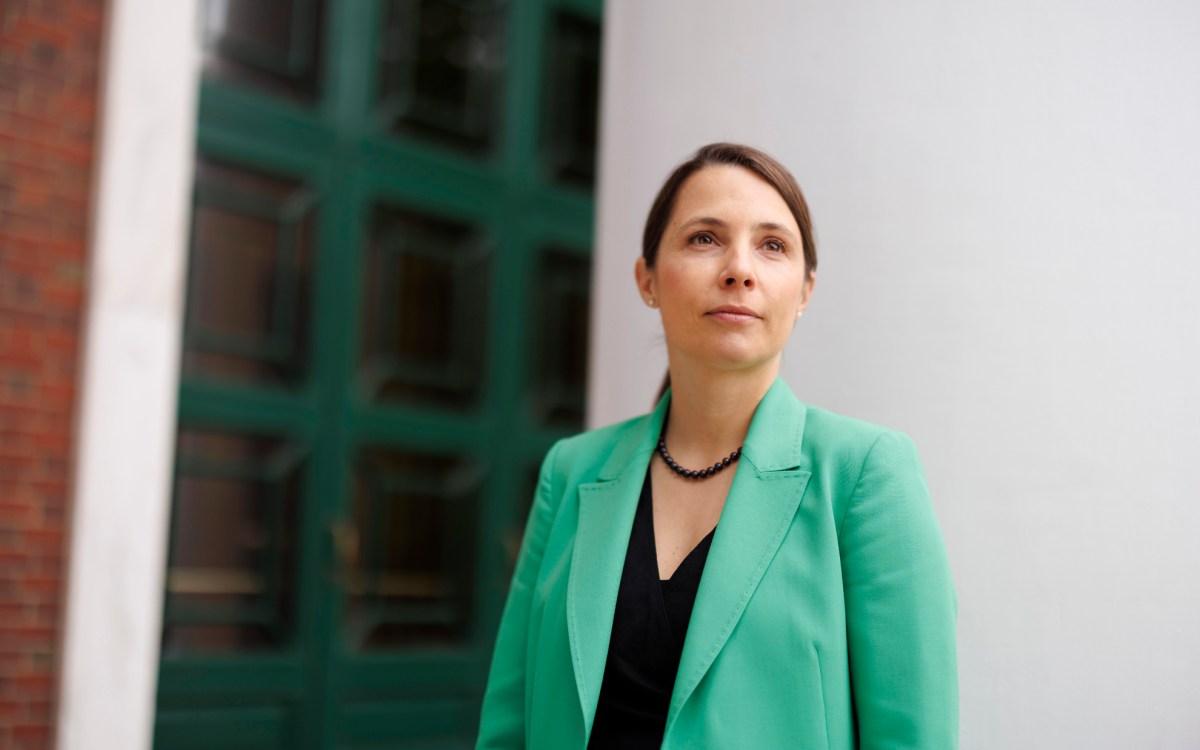
The entrance to Annenberg Hall and Memorial Hall in Harvard Yard.
Kris Snibbe/Harvard Staff Photographer
Steps to zero
Harvard Management Company checks in on the promise to reduce greenhouse gas emissions
Last April, Harvard made a first-of-its-kind commitment to stem the effects of climate change, pledging the University’s investments would achieve net-zero greenhouse gas emissions by 2050. That promise took its place beside other ways that Harvard is confronting the threat posed by climate change, such as its ongoing commitments in research and education as well as efforts to reduce the University’s own use of fossil fuels.
To that end, the Harvard Corporation, which oversees the University’s endowment, directed Harvard Management Company (HMC) to provide an early assessment of its portfolio, along with how HMC will measure progress toward the 2050 goal. Today, HMC released its initial report, which includes next steps.
The Gazette spoke with Michael Cappucci, managing director for compliance and sustainable investing at HMC, to learn more about the work to date and how this first year has refined HMC’s outlook on the path to 2050.
Q&A
Michael Cappucci
GAZETTE: Could you remind us of the commitment Harvard made last April and how the target date was determined?
CAPPUCCI: Simply put, the commitment is to manage the endowment portfolio in a way that our investments produce net-zero greenhouse gas emissions by the year 2050.
So what does this mean? Well, right now, if the world proceeds on a “business as usual” pathway, we would be on a trajectory for a temperature increase by the end of this century of somewhere between 3 and 4 degrees Celsius above preindustrial levels, which would be catastrophic.
In order to avoid the worst-case scenarios, we need to limit the temperature increase to 2 degrees Celsius or less. To do this, the Intergovernmental Panel on Climate Change says that the world needs to reach net-zero greenhouse gas emissions by around the year 2050. That fact has become widely understood and is reflected in the Paris Agreement, which was the standard that Harvard applied when making this pledge. That’s where the timeline comes from.
GAZETTE: I can’t imagine it will be easy to reach this goal, for anyone, and there are likely financial risks for the University associated with taking this path. Why did Harvard choose this route?
CAPPUCCI: Harvard economist John Campbell did a good job of delineating the risks, and why Harvard was forging ahead with this decision despite them, in this space last year.
In short, Campbell acknowledged that, in the near-term, there could be some cost, since the market still includes carbon-emitting companies that will likely offer higher returns to investors who remain willing to invest in them. But over time, if Harvard, and the like-minded institutions that join in the commitment, are successful in changing the carbon profile of the entire economy by 2050, we could all stand to benefit by being better positioned against risks associated with the transition away from fossil fuels.
Really, this is why we’ve chosen this route, which frankly does more than simple divestment. We see it as our responsibility to encourage others to join us, toward creating an economy that is fully net-zero by 2050.
GAZETTE: How do you start a process like this? And have you encountered hurdles that you didn’t expect?
CAPPUCCI: Our initial steps were twofold. First, we needed to figure out what data was out there, among our existing investments, for us to measure, and, perhaps more importantly, what data we need to get our hands on for accurate measurements. Second, we began work on establishing a methodology for measuring emissions across the variety of investments types (asset classes) in which the endowment is invested.
As far as collecting data, I think that’s best characterized as a predictable hurdle. The report goes into this in more detail, but, essentially, under HMC’s current investment model, we do not actively buy and sell stocks and bonds and other securities ourselves. Instead, we select managers, primarily fund managers, who we believe are experts in their respective fields or strategies, to do the investing for us. This is an investment model that has worked well in the endowment world for going on 40 years. But what this means is that we don’t have any control over the selection of the underlying securities. And in most cases, we don’t even know what those securities are. HMC relies almost entirely on external asset managers and so there are layers between us and the data — public equity funds where we currently do not get reporting on the specific securities in the fund, and private equity funds where the investments are more easily discernable but don’t yet report on greenhouse gas emissions.
As for methodology, we are closely following the work being done across the industry. Organizations like the Net Zero Asset Owner Alliance, Institutional Investors Group on Climate Change, Science Based Targets Initiative, and Ceres are all doing work to help institutional investors that have made net-zero commitments. But because of the unique nature of HMC’s portfolio and our tilt toward alternative investments, we may have to develop some of it on our own.
GAZETTE: Harvard was the first higher education endowment to announce a net-zero commitment. Others in higher education have since followed, and of course organizations across other sectors have made similar commitments. Does collaboration with other companies or investors make the task easier?
CAPPUCCI: Without question, it helps to have shared goals and we have benefited greatly from speaking with peers over the past year to get a better understanding of how they’re tackling the challenge. Hopefully, we will see even more institutions join this cause in the years ahead, but each pledge needs to be tailored to its institution. The path for an endowment is inherently different than the path for, say, Microsoft or a major pension fund.
It is worth remembering, though, that the net-zero pledge also includes encouraging more companies to commit to strive for net-zero emissions and working with others that are considering it. Hopefully, in the years to come, greater numbers will mean faster progress and standardized reporting.
GAZETTE: It sounds like the focus is on data and measurement at this stage, but what else can HMC do with regard to its 2050 net-zero emissions goals?
CAPPUCCI: It’s certainly true that before we can set reasonable targets for incremental greenhouse gas reduction, we need to know what the exposure is in our existing investments. However, there are other efforts that began before the pledge that also support the effort.
The biggest initiative that we are involved with at the moment is the Climate Action 100+, which is an investor-led collaboration to ensure that the world’s largest corporate greenhouse gas emitters take steps to address climate change. Through this program, more than 500 investors representing over $52 trillion in assets under management have committed to engage with 160 focus companies to reduce emissions and improve climate disclosure and governance. In most cases, these are one-on-one-type engagements, where investors like us are speaking directly to individual companies. Since joining in 2019, Harvard, for its part, has engaged directly with four different companies on planning projects to help them to similarly reach net-zero greenhouse gas emissions by 2050, including a power company, an electric utility company, an oil exploration company, and a gas and oil company.
GAZETTE: It’s only been 10 months since Harvard made its commitment, but the report also provides an assessment of where the University is now in terms of its endowment portfolio. Can you tell us more about where Harvard is in 2021, with regard to its initial steps toward reaching net-zero emissions?
CAPPUCCI: As I mentioned, we’ve already been spending significantly more time than before working with our fund managers on strategies to most effectively move our portfolio to meet our commitment to net-zero emissions by 2050. HMC was able to report that, as of the end of its last fiscal year, June 30, 2020, the endowment did not directly own the securities of any companies that explore for, or develop, further reserves of fossil fuels. HMC has also significantly reduced its overall exposure to fossil fuels — including both direct commodity investments and indirect investments held through externally managed funds — from approximately 11 percent of the portfolio at the end of fiscal year 2008 to less than 2 percent at the end of fiscal year 2020. This marks a decrease of more than 80 percent, in little over a decade.
So, we were already making moves to decarbonize our portfolio prior to this commitment, and we’ve made some solid progress. It’s a great start along an uncharted path. This is a vital commitment made by the University toward solving one of the major issues of our time, but there is much more work to do. We are hopeful that many more institutions will join us.
Interview has been lightly edited for space.








